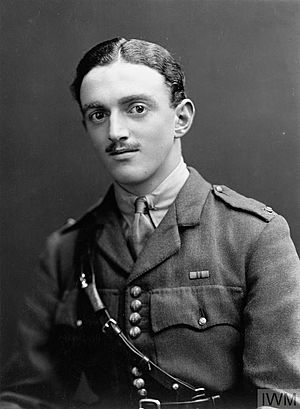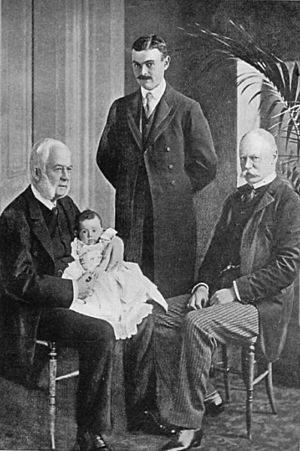Charles Gordon-Lennox, Lord Settrington facts for kids
Quick facts for kids
Lieutenant
Lord Settrington
|
|
|---|---|
 |
|
| Born | 26 January 1899 67 Cadogan Square, London, United Kingdom |
| Died | 24 August 1919 (aged 20) Berezniki, Severnaya Oblast, Russian State |
| Buried |
Archangel Allied Cemetery, Arkhangelsk, Arkhangelsk Oblast, Russia
|
| Service/ |
|
| Years of service | 1916–1919 |
| Rank | Lieutenant |
| Unit |
|
| Battles/wars | |
| Relations |
|
Charles Henry Gordon-Lennox, Lord Settrington (born January 26, 1899 – died August 24, 1919) was a young British nobleman. He was expected to inherit important titles like the Dukedom of Richmond. Charles served as a lieutenant in the British Army during World War I and the Russian Civil War. Sadly, he was killed during a conflict known as the North Russia intervention.
Contents
Growing Up as Lord Settrington
Charles Gordon-Lennox was born on January 29, 1899, in London. His parents were Lord Settrington (who later became the 8th Duke of Richmond) and Hilda Madeline Brassey. Charles became the heir to several important noble titles because his older brother had passed away as a baby. These titles included the Dukedoms of Richmond, Lennox, and Gordon.
From 1903, when his great-grandfather died, Charles was known by the special title of Lord Settrington. He grew up at Molecomb House, which was part of his family's large Goodwood Estate in West Sussex.
When he was four, Charles attended the birthday party of Prince Edward of Wales, who would later become King Edward VIII. In 1911, Charles was a page (a ceremonial attendant) for his grandfather at the coronation of King George V. His grandfather had an important role, carrying the Sceptre with Dove.
Charles went to two well-known schools: Eton College and the Royal Military College, Sandhurst. These schools prepared him for a life of leadership and military service.
Military Service in Two Wars
Serving in World War I
On October 26, 1916, Charles became an officer in the Irish Guards as a second lieutenant. He was later promoted to lieutenant on July 22, 1917.
In April 1918, during the Battle of Hazebrouck, Charles went missing in action after three days of heavy enemy attacks. He had been captured by German forces and became a prisoner of war in Karlsruhe, Germany. He remained a prisoner until the war ended with the Armistice of 11 November 1918 in November 1918. Charles returned to England in December 1918.
Joining the Russian Civil War
After the October Revolution in Russia, several countries, including Britain, got involved in the Russian Civil War. This was called the Allied intervention. They supported the "White movement" against the Bolsheviks.
Charles, feeling bored with civilian life after World War I, volunteered to join the 45th Battalion of the Royal Fusiliers. He was sent to North Russia as part of the North Russia intervention.
On August 10, 1919, British troops advanced near Arkhangelsk and attacked Bolshevik positions. They captured two villages, Sludka and Lypovets. The next morning, Charles's company was crossing a temporary bridge over the Sheika River. They came under enemy fire, and Charles was shot in the chest, falling into the river. An Australian soldier named Arthur Sullivan bravely pulled Charles and three other soldiers from the river. Sullivan was later awarded the Victoria Cross for his heroic actions.
His Death and Lasting Memory
Lord Settrington died from his injuries in Berezniki, Russia, on August 24, 1919. He was only 20 years old. He was buried in the Imperial War Graves Commission's Archangel Allied Cemetery. A special memorial service was held for him in London.
Charles was considered a very close friend of Lady Elizabeth Bowes-Lyon, who later became the Queen Mother. She was a good friend of Charles's sister, Lady Doris. After his death, Lady Elizabeth wrote about him, calling him "my only true friend." She said he was "completely unique" and that she missed him very much.
A memorial plaque honoring Charles and his father was placed in the Church of St Mary and St Blaise in Boxgrove, near the Goodwood Estate.



